The theme for the Historical Sew Monthly Challenge #9 is Brown: make something in any shade of brown.
Brown is not generally my favourite colour, but I’m getting quite ambitious about this challenge, and have actually gotten very excited as I’ve researched it, so I may come around to brown yet! And I’ve found so many beautiful things in finding pieces for the inspiration post!
Brown should be an easy one for everyone to do, because brown has been such a popular colour throughout history: there is almost no period, no people, no rank or station that hasn’t worn brown. Hopefully there will be entries to represent all sorts of periods, places, levels of stations, and all shades of brown!
And now, for some inspiration…
True browns are less common in Medieval illustrations than they were in Medieval clothing, simply because the illustrators went for bright shades for visual effect, and coloured illuminations are more likely to depict the upper classes, where brighter colours were a status symbol. Plus, some colours have faded to brown over time. But I’m pretty sure Atalante’s frock was always brown, and isn’t it beautiful with her red under-gown!
For another high-status brown, here is Jan Janz Mostaert’s beautiful Portrait of a Lady. I love the way the rich brown brocade of her over-dress mirrors the rich brown of the fur lining, and complements the pinks of her under-dress. Delicious!
Fawn and copper were both very popular colours in the mid 17th century, as these two Lely portraits show admirably:

Elizabeth Wriothesley, Countess of Northumberland, later Countess of Montagu (1646-90), by Peter Lely, c. 1668
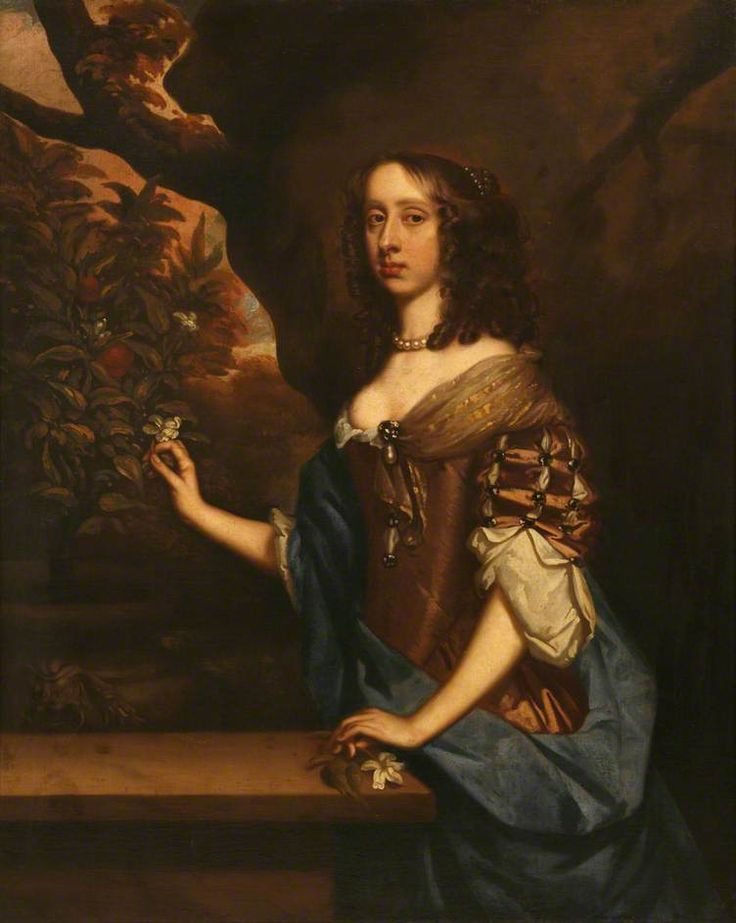
Jemima, 1st Countess of Sandwich, studio of Peter Lely, ca. 1660; (c) Mount Edgcumbe House; Supplied by The Public Catalogue Foundation
I absolutely adore this early 18th century jacket, the beautiful bizarre silk it is made from, and the masterful use of the fabrics pattern in its design:
I’m still obsessed with 18th century chine a la branche silks, and I’ve noticed that they all come in shades of palest tan and the most classic 18th century shade of all, the pink-brown known as puce.
18th century menswear can be a bit over the top, but this jacket is both severe and fabulous.
Lovely!
Brown was, of course, a common colour for stays and other under-things in the 18th century, and the working classes made all manner of garments, including shifts, from unbleached brown linen.
As with all colour challenges, the item doesn’t have to be exclusively brown, as long as the brown component is a significant part of it. This dress may be predominantly lilac, but the beige flowers give it interest and visual impact, and even the briefest description is likely to say that it is lilac and light brown.
And because gorgeous mid-19th century flowers aren’t just for women….
Accessories are a great way to bring brown into an outfit if a whole brown garment is too much. I love this little bonnet:
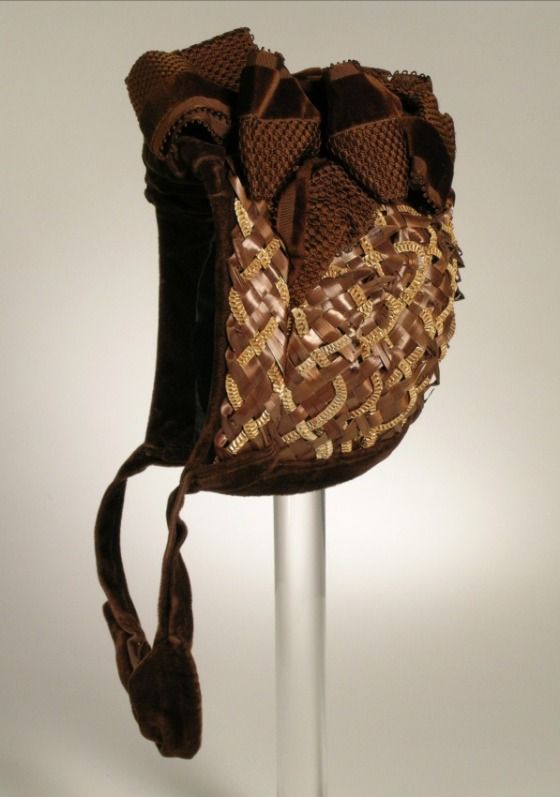
Woman’s Bonnet
E. Dreyer (United States, Pennsylvania, Pittsburgh, active 19th century)
Constructed in France for the United States market; materials from Switzerland or Japan, circa 1890
Costumes; Accessories
Barley straw and synthetic celluloid, silk velvet, Los Angeles County Museum of Art, M.60.22.4
This ensemble got rather ravaged in Rate the Dress, but I still think it’s fascinating, and has distinct possibilities:
For an example of brown linen, not the 18th century kind, this brown linen summer ensemble:
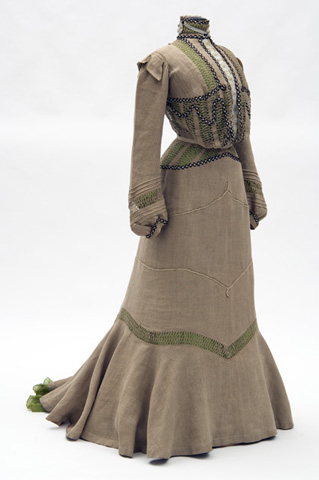
Day dress of unbleached linen with green silk underslip, 1901-2, Misses Leonard, St. Paul, US, Minnesota Historical Society
In more recent decades, brown has become a popular autumn colour, and is seen a lot in coats and tweeds, as in this chic 1935 number with matching cape:
Gorgeous! Happy sewing!

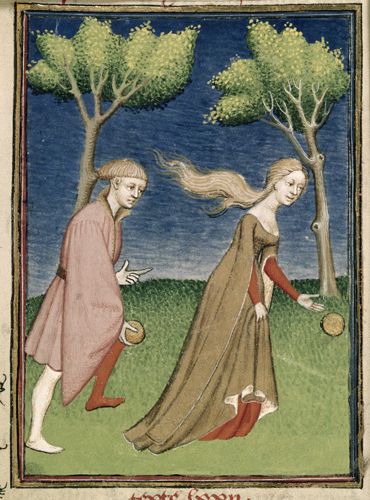

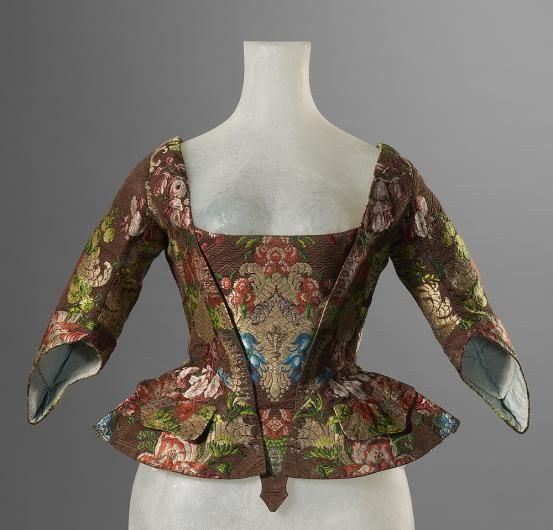


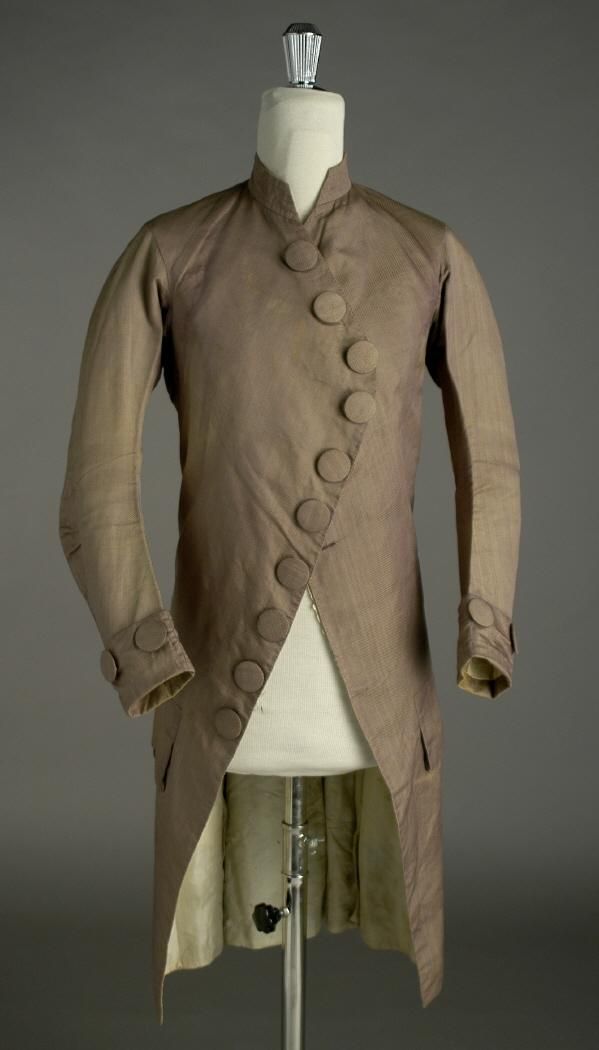

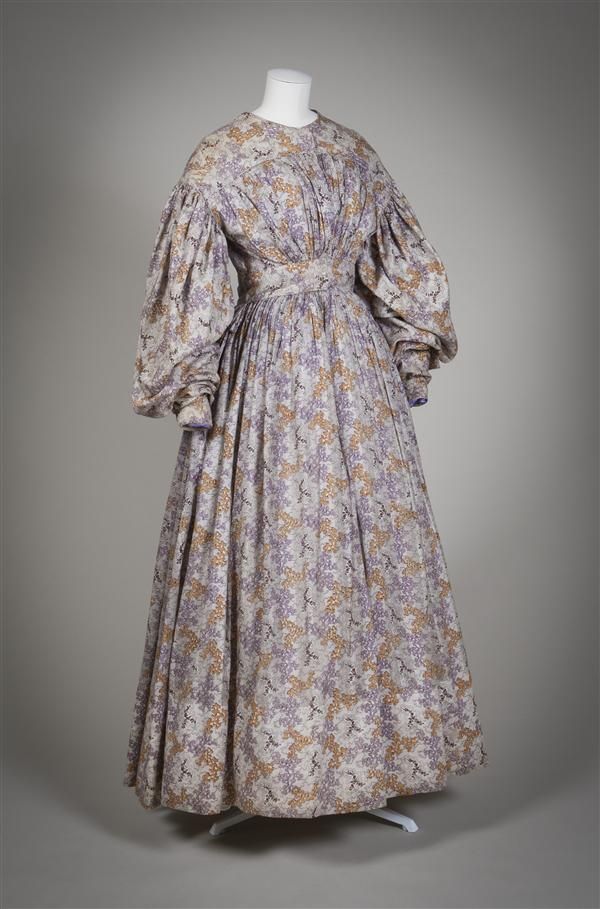
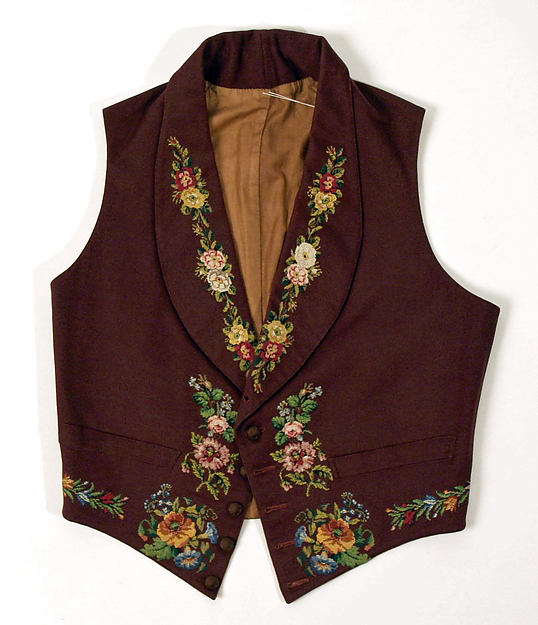
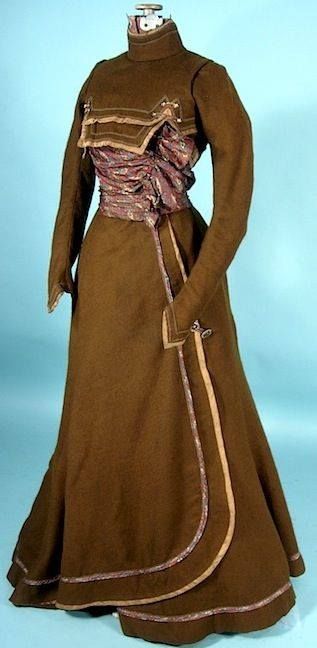
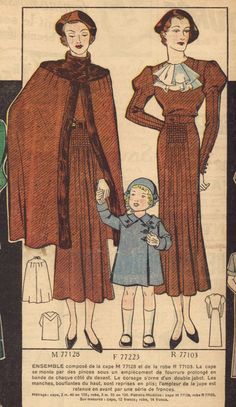
Wow, I love this collection of items — particularly the waistcoat from the Met.
Thank you! That waistcoat is pretty darn special isn’t it?
Sigh… I love brown, and as you point out, it has so many historical possibilities. I’m looking forward to seeing what people bring forth to meet the challenge!
metmuseum.orgAnd then there’s the brown silk round gown from the MET I’ve been in love with for years… Put on a horrible mannequin by the museum for some reason. But yummy. It’s like chocolate in dress form. Sadly, I’m not going to recreate it, because silk like that is rather outside my reach.
http://www.metmuseum.org/collection/the-collection-online/search/107928
Oooh, that is gorgeous! The precision of those pleats in back! Swoon!
Don’t give up hope for recreating that – it’s a plain silk, and not that rare to find something that probably has a very a similar hand, so you might get lucky one day! I have (more than once) found silks in op shops at ridiculously low prices. If I ever find a lightweight brown silk that I think might be right I’ll definitely think of you 😉
It’s different here, or I don’t know where to search; fabric itself is rather rare, and silk? Unheard of, unless I unpick an existing dress.
But I mostly meant that I’m not going to recreate it for this challenge; I partially blew my new fabric money on a designer quilting cotton with a lovely print that’s going to be something for this challenge. 😉
The back of that dress is exquisite. I’ve been returning to that back for years and still haven’t grown tired of it; all the lines in it come together beautifully yet in ways that are fresh to modern eyes. It’s a pity there isn’t another view of the front; I’d like to know how the skirt comes together to hang like that.
That manikin is horrible!
Beautiful inspiration images on brown, thank you! I’m looking forward to this challenge and adding more brown to my historical wardrobe!
If I can do it amidst the start of school for my kids and all the other family obligations I’d like to try to do something similar to the wonderful brown redingote LACMA has in their collection.
http://collections.lacma.org/sites/default/files/remote_images/piction/ma-1415404-WEB.jpg
I’ve got the perfect striped silk for it…
Not forgetting Liotard’s La Belle Chocolatière from 2013
https://thedreamstress.com/2013/03/rate-the-dress-the-chocolate-girl-of-the-1740s/
Have you ever looked at costumes of fashion dolls through the years?
I know what I want to make, an 1810ish spencer, main thing to decide is which fabric. I have a caramel tweed wool or chocolate cotton velvet and it’ll be going with my blue drop front dress.
As a redhead (a faux redhead now, alas, but still a redhead), I love browns.
I’ve had an idea about what to do for this challenge (assuming I manage to make the time to do it). However, I need a nice brown wool for the purpose and I’m not sure where best to find such a thing cheap. If I do, I’ll blog about my intentions.
I found a fabulous brown wool for my Finnish costume – perfect timing! http://wp.me/p1g3u4-22N
Here is my 1919 Brown Plaid Outfit!
http://aimeevictorianarmoire.com/2015/09/23/the-1919-ensemble/
I actually finished this challenge with time to spare! I re-trimmed my brown 1840’s bonnet and added a bonnet stay. It actually stays on my head now!
http://thesewinggoatherd.blogspot.com/2015/09/wearing-purple-plaid-wool.html
I made a collection of brown items this month!
http://levagabondage.blogspot.com/2015/09/hsf-challenge-brown.html
A dress and a skirt from the Twenties: https://aboutmybuttonbox.wordpress.com/2015/09/30/hsm-8-9-colour-challenge-brown-and-sewing-secrets-autumn-wardobe/
I made an 18th century ‘housewife’ or sewing kit, in rose, blue & brown from leftover scraps in the stash: http://theladydetalle.blogspot.com/2015/09/18th-century-sewing-kit-or-housewife.html
I felt very much like an 18th century woman would have made one this way at home, using small, leftover pieces of previous projects (a dress, a muff, etc.). It was fun to make!
Finally got around to posting my September entry…three months later, oops. Pleating the petticoat and actually photographing it sure held up the process!
Construction: http://youngsewphisticate.blogspot.com/2015/12/short-gown-study-iii.html
Photo shoot: http://youngsewphisticate.blogspot.com/2015/11/ode-to-autumn-1830s-photo-shoot.html